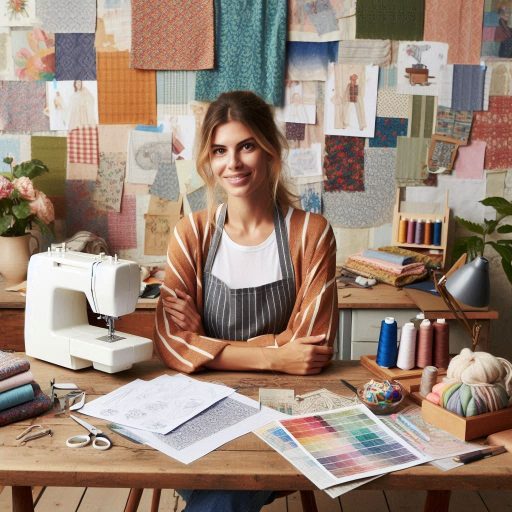Introduction
Design is a multifaceted process that involves creating solutions that are not only visually appealing but also functional and effective.
It encompasses various disciplines, including graphic design, product design, interior design, and digital design.
In today’s fast-paced world, design plays a vital role across numerous industries, such as technology, fashion, architecture, and marketing.
Good design enhances user experience, communicates messages effectively, and drives innovation, making it an essential component of successful business strategies.
At the heart of effective design is the delicate balance between creativity and business acumen.
Creativity is the driving force behind originality and innovation; it allows designers to think outside the box, explore new ideas, and push boundaries.
However, without a solid understanding of business principles, even the most innovative designs can fail to resonate with the intended audience or meet market demands.
Designers must consider practical aspects such as target demographics, budget constraints, and project timelines while crafting their creative visions.
Finding the right balance between creativity and business is crucial for long-term success in the design field.
When designers prioritize creativity without considering business objectives, they risk producing work that, while visually impressive, lacks commercial viability.
Conversely, a design process that is overly focused on business considerations can lead to uninspired results that fail to captivate audiences.
Therefore, designers must cultivate the ability to merge artistic expression with strategic thinking.
Understanding the target audience
Importance of Knowing the Audience’s Preferences and Needs
Understanding the target audience’s preferences and needs is crucial for balancing creativity and business in design.
Designers must create work that resonates with the audience emotionally and functionally.
Without this understanding, even the most creative designs may fail to connect with users.
Knowing what appeals to the audience helps designers produce work that is not only visually captivating but also relevant and engaging.
By aligning design decisions with audience expectations, designers ensure that their work successfully serves its purpose while achieving business goals.
How to Conduct Market Research to Gather Information
Market research is essential for gathering information about the target audience.
Designers can use surveys, interviews, and focus groups to get direct feedback from users.
These methods provide insights into the audience’s demographics, preferences, and behavior patterns.
Social media analytics and website data also offer valuable information on how the audience interacts with digital content.
By studying these patterns, designers gain a deeper understanding of the audience’s likes, dislikes, and needs.
This research informs the design process and helps ensure that creative choices align with user expectations.
How Understanding the Target Audience Can Help in Balancing Creativity and Business in Design
Understanding the target audience plays a critical role in balancing creativity and business in design.
While creativity drives innovation, it must be guided by the audience’s needs to ensure commercial success.
Audience insight helps designers make informed decisions that satisfy both artistic and business goals.
For example, a visually stunning design may not work if it doesn’t address the user’s practical needs.
By focusing on the audience, designers can strike a balance between creative expression and functionality, creating work that appeals to users and supports business objectives.
Generally, understanding the target audience is key to creating designs that balance creativity with business success.
Designers who prioritize audience research can craft innovative, engaging work that resonates with users while meeting business goals.
Read: Famous Costume Designers in Hollywood
Setting Clear Goals and Objectives
Importance of Defining Clear Goals for a Design Project
Setting clear goals and objectives is essential for the success of any design project.
Well-defined goals provide direction and focus throughout the design process.
They help designers understand the project’s purpose and desired outcomes.
Without clear goals, projects can become unfocused, leading to wasted time and resources.
Clear objectives also facilitate effective communication among team members and stakeholders.
Everyone involved can align their efforts toward common goals, ensuring that the final design meets expectations.
How to Align Creative Ideas with Business Goals
Aligning creative ideas with business goals is crucial for creating impactful designs.
Designers must understand the organization’s objectives, target audience, and market positioning.
This knowledge allows them to develop creative solutions that resonate with users while supporting the business’s strategic aims.
To achieve this alignment, designers can start by engaging with stakeholders to discuss project objectives.
Regular meetings can help clarify priorities and adjust creative concepts to align with business goals.
Incorporating user feedback into the design process further ensures that creative ideas serve the audience’s needs while achieving organizational aims.
The Impact of Having Clear Objectives on the Success of a Design Project
Having clear objectives significantly impacts the success of a design project.
When goals are well-defined, designers can measure their progress and evaluate their work against specific criteria.
This clarity helps identify potential challenges early on and allows for timely adjustments.
Projects with clear objectives are more likely to stay on schedule and within budget, enhancing overall efficiency.
Furthermore, clear goals provide a framework for assessing the design’s effectiveness post-launch.
Designers can analyze outcomes based on established objectives, making it easier to determine what worked and what needs improvement.
Setting clear goals and objectives is vital for any design project.
It ensures that creative ideas align with business goals and enhances the project’s overall success.
By defining clear objectives, designers can create focused, effective designs that resonate with the target audience and fulfill business needs.
Collaboration with Clients and Team Members
Importance of Effective Communication with Clients and Team Members
Effective communication is crucial for successful collaboration between clients and team members.
Clear communication helps set expectations, define project scopes, and ensure everyone is on the same page.
It allows designers to understand clients’ needs, preferences, and feedback, which is essential for creating designs that meet those needs.
Regular check-ins and updates keep clients informed about project progress, fostering trust and transparency.
Moreover, open lines of communication among team members encourage idea sharing and ensure that all voices are heard.
This synergy ultimately leads to more cohesive and successful design outcomes.
How Collaboration Can Lead to Innovative and Successful Design Solutions
Collaboration can significantly enhance the creative process, resulting in innovative and successful design solutions.
When diverse perspectives come together, they create a rich environment for brainstorming and problem-solving.
Team members can challenge each other’s ideas, leading to new approaches and solutions that may not have emerged in isolation.
Additionally, involving clients in the design process allows for real-time feedback, ensuring that the project aligns with their vision.
This collaborative spirit fosters creativity and enhances the quality of the final product, making it more likely to resonate with the target audience.
Strategies for Fostering a Positive Working Relationship with Clients and Team Members
Fostering a positive working relationship with clients and team members is essential for effective collaboration.
One strategy is to establish clear roles and responsibilities from the outset.
This clarity helps everyone understand their contributions and how they fit into the overall project.
Additionally, creating a culture of respect and open-mindedness encourages team members to share their ideas freely.
Implementing regular feedback sessions also promotes an atmosphere of continuous improvement.
It allows for constructive criticism and reinforces that all input is valued.
Building rapport with clients is equally important.
Taking the time to understand their vision and values fosters a sense of partnership.
Scheduling regular meetings and check-ins can help maintain open communication and address any concerns promptly.
Using collaborative tools like project management software can also streamline communication and keep everyone aligned on project milestones.
Effective collaboration with clients and team members is vital for successful design projects.
Clear communication, teamwork, and positive relationships lead to innovative solutions that meet client needs.
By implementing strategies that encourage collaboration, designers can create a more dynamic and successful design process.
Read: Networking Events for Costume Designers
Budgeting and Resource Management
Importance of Budgeting and Resource Management in Design Projects
Budgeting and resource management are crucial for the success of design projects.
A well-planned budget helps ensure that projects remain financially viable.
It provides a framework for allocating funds effectively and avoiding overspending.
Effective resource management maximizes the use of available assets, such as time, talent, and materials.
By managing resources wisely, designers can deliver high-quality work while meeting deadlines and client expectations.
Overall, good budgeting and resource management minimize risks and enhance project outcomes, ensuring that creative visions are realized without financial strain.
How to Prioritize Creative Ideas Within Budget Constraints
Prioritizing creative ideas within budget constraints requires careful evaluation and strategic decision-making.
Designers must assess which ideas align best with the project goals and client expectations.
One effective approach is to categorize ideas based on their potential impact and cost.
High-impact, low-cost ideas should take precedence, as they provide the best return on investment.
Designers can also conduct cost-benefit analyses to determine the feasibility of each creative concept.
By focusing on ideas that deliver the most value within budget limitations, designers can balance creativity with practical considerations.
Strategies for Effective Resource Allocation and Project Planning
Implementing strategies for effective resource allocation and project planning is essential for staying within budget.
One strategy involves creating a detailed project timeline that outlines key milestones and deliverables.
This timeline helps allocate resources more effectively by ensuring that team members know their responsibilities and deadlines.
Additionally, utilizing project management tools can facilitate collaboration and keep everyone informed about progress and changes.
Another strategy is to maintain open communication with clients about budget limitations.
Discussing financial constraints early in the process fosters transparency and helps manage client expectations.
This dialogue allows for adjustments to the project scope or creative direction as needed, ensuring that the final design aligns with both budget and vision.
Regularly reviewing budget performance throughout the project is also critical.
This practice allows designers to identify potential overspending early and make necessary adjustments.
By keeping a close eye on expenses, designers can make informed decisions that align with both creative goals and financial realities.
Effective budgeting and resource management are vital for the success of design projects.
By prioritizing creative ideas within budget constraints and implementing effective planning strategies, designers can create high-quality work while managing resources efficiently.
Ultimately, good budgeting practices lead to successful outcomes that meet client needs and enhance the overall design process.
Read: Essential Skills for Aspiring Costume Designers

Continuous Learning and Skill Development
Importance of Staying Updated with Industry Trends and Technologies
In the fast-paced design industry, staying updated with trends and technologies is essential.
Rapid changes in design tools, techniques, and user preferences require designers to adapt continually.
Keeping abreast of industry trends helps designers create relevant and modern work.
It also enables them to leverage new technologies that can enhance their design processes and outcomes.
By understanding current trends, designers can identify emerging opportunities and threats, ensuring they remain competitive.
This commitment to learning fosters innovation and creativity, allowing designers to push boundaries and deliver exceptional results.
How to Enhance Creativity and Business Skills Through Continuous Learning
Continuous learning is vital for enhancing both creativity and business skills in design.
Designers can take advantage of various resources, such as online courses, webinars, and workshops, to expand their knowledge.
Engaging in creative activities, such as sketching, writing, or exploring new design styles, can also stimulate innovative thinking.
Additionally, learning about business concepts, such as marketing and project management, equips designers with valuable skills that can elevate their work.
This combination of creative and business knowledge enables designers to make informed decisions that align with both artistic vision and client objectives.
The Benefits of Investing in Professional Development for Designers
Investing in professional development offers numerous benefits for designers.
First, it enhances skill sets and knowledge, making designers more versatile and adaptable.
This increased competence leads to improved job performance and greater confidence in their abilities.
Second, ongoing education fosters networking opportunities, allowing designers to connect with industry peers and leaders.
These connections can lead to collaborations, mentorship, and new job opportunities.
Moreover, professional development keeps designers motivated and engaged in their work.
Learning new skills can reignite passion for the field and inspire fresh ideas.
This renewed enthusiasm often translates into higher quality work and more innovative design solutions.
Lastly, organizations that support professional development see higher employee satisfaction and retention rates.
When designers feel valued and invested in, they are more likely to remain loyal to their employers, contributing to a more stable and productive work environment.
Continuous learning and skill development are vital for designers in today’s ever-evolving industry.
Staying updated with trends, enhancing creativity, and investing in professional growth lead to greater success and fulfillment.
By committing to lifelong learning, designers can thrive in their careers and continue to deliver outstanding design solutions.
Read: Essential Skills for Aspiring Costume Designers
Transform Your Career Today
Unlock a personalized career strategy that drives real results. Get tailored advice and a roadmap designed just for you.
Start NowEmbracing Feedback and Iteration
Importance of Seeking Feedback from Clients and Peers
Seeking feedback from clients and peers is essential for improving design quality.
Clients provide valuable insights into their needs and preferences, ensuring that designs align with their vision.
Peer feedback offers diverse perspectives that can enhance creativity and identify potential flaws.
Regularly soliciting feedback fosters an open dialogue, encouraging collaboration and trust between designers and stakeholders.
Embracing this input helps designers refine their work, ultimately leading to more effective and impactful design solutions.
This iterative process cultivates a culture of continuous improvement, ensuring designs meet both creative and business standards.
How to Use Feedback to Improve Design Solutions
Using feedback effectively requires a systematic approach.
First, designers should actively listen to the feedback provided, ensuring they understand the core messages.
It’s helpful to ask clarifying questions to gain deeper insights into specific concerns.
Once feedback is gathered, designers can categorize it into actionable items, focusing on recurring themes or critical issues.
Prioritizing feedback based on its relevance and potential impact allows designers to address the most pressing concerns first.
After implementing changes based on feedback, designers should communicate these adjustments to clients and peers.
This step reinforces the value of their input and demonstrates a commitment to collaboration.
Additionally, soliciting further feedback on the revised designs ensures a continuous cycle of improvement, leading to increasingly refined solutions.
The Role of Iteration in Refining Creative Ideas and Achieving Business Objectives
Iteration plays a crucial role in refining creative ideas and achieving business objectives.
The design process is rarely linear; instead, it often involves multiple rounds of adjustments and enhancements.
By embracing iteration, designers can explore various concepts, test new approaches, and make informed decisions based on real-world feedback.
This iterative process encourages experimentation, allowing designers to push the boundaries of their creativity while remaining focused on the project’s goals.
Each iteration provides an opportunity to evaluate how well the design aligns with both user needs and business objectives.
By regularly assessing the impact of changes, designers can ensure their solutions not only look good but also function effectively.
This iterative approach minimizes the risk of costly mistakes, as designers can identify and address issues early in the process.
Embracing feedback and iteration is essential for achieving success in design projects.
Seeking input from clients and peers fosters collaboration and leads to improved design solutions.
Iteration allows designers to refine their ideas continually, ensuring they align with both creative vision and business objectives.
By committing to this iterative process, designers can create more effective, innovative, and impactful design outcomes.
Conclusion
Balancing creativity and business in design is essential for sustained success in today’s competitive market.
Designers who master this balance can produce innovative, visually compelling work that also meets practical business needs.
Creativity is the driving force behind fresh, original ideas, but without an understanding of business objectives, those ideas may not have the desired impact or profitability.
Designers need to learn how to align their creative concepts with the broader goals of the organizations or clients they work for.
This involves being mindful of budgets, deadlines, target audiences, and market trends, while still allowing space for artistic expression and innovation.
By embracing this dual approach, designers can create work that not only stands out visually but also serves a clear business purpose.
Key takeaways for designers include the importance of adaptability, open communication with stakeholders, and a willingness to merge creativity with strategy.
Embracing both creativity and a business mindset is the key to a long and successful career in the design industry.
[E-Books for Sale]
The Big Book of 500 High-Paying Jobs in America: Unlock Your Earning Potential
$19.99 • 500 High-Paying Jobs • 330 pages
Explore 500 high-paying jobs in America and learn how to boost your career, earn more, and achieve success!
See All 500 High-Paying Jobs of this E-Book
1001 Professions Without a Degree: High-Paying American Jobs You Can Start Now
$19.99 • 1001 Professions Without a Degree • 174 pages
Discover 1001 high-paying jobs without a degree! Unlock career tips, skills, and success strategies for just $19.99!




